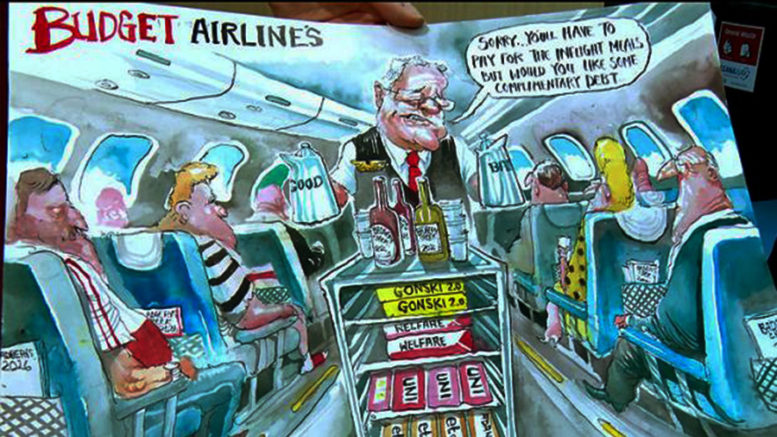Contributed by Joe Montero
A simple way to describe the 2017-18 federal budget is that it comes from a government running scared. It pretends to be giving away a few concessions with one hand and then slugs the punters with the other, for it hinges on running away the responsibilities of government and lifting the privatisation push.
Even the minimal giveaways fit into this scenario. The pattern is, a little is given with one hand and more is taken away with the other, cementing in the pattern of user pays that is a necessary step towards extending privatisation.
The lack of heart is best seen in the treatment of those on Centrelink benefits. It is not only the unemployed, but also the disabled, single parents and the aged. For these groups, life will only get tougher, when the whole package comes into effect. There is no commitment to do away with the robo debt system, or invest in improving services, so there are positive outcomes and those dealing with the system are treated with dignity and respect. There are even more measures, to put Centrelink recipients in a more precarious position
We get the axing of more than 1,000 jobs in the department, cutting funding to Centrelink by $632 million in one year and a higher level of contracting out services to private providers. The outcome of private provider outcomes will be no different to the job training programs that have become a joke, bringing training on the cheap and an easy money scam for the operators.
A similar story applies to health services. A great play is being of putting new drugs onto the pharmaceutical Benefits Scheme (PBS) and shifting to extending the use of generic products. These are good changes in themselves. But they are not so good, when they come attached to the progressive cut in government funding of the PBS. This can only come about if customers are made to pay the growing gap between the price over the counter and the government subsidy. The stage has been set for future increases in the cost of medicines.
The Medicare levy is to rise from the current 2 percent to 2.5 percent. Cash strapped hospitals and other medical services get nothing.
On taxation, there is a commitment to cut all company tax to 25 percent and nothing is to be done to recapture the billions of dollars lost every year, through the tax avoidance industry.
It is true that the banks will be hit with a tax that is claimed will raise $8.2 billion years over four years. Political need requires the government to be seen to be doing something, when Australians generally see the banks as greedy money grabbers, paying too little pack in return. However, this is only a drop in the bucked, compared with the level of tax avoidance that the banks are central to.
The rest of us get to pay more tax, for less in return.
Look at housing. Its growing unaffordability is the number one reason for falling living standards and growing poverty. The answer. First home buyers will be allowed to use superannuation money. The effect of this will be to heat the market further and raise prices of dwellings and rents even further. The problem is not the supply of housing. Melbourne and Sydney each have about 80,000 unoccupied dwellings and this is replicated around the country. Cutting back on negative gearing is negligible. There is no commitment to increasing the public stock or to impose any form of rent control. These measures would work to lower the price.
These few examples provide a good picture of what is going on.
Notice that the budget deficit rhetoric has been toned down. The truth is that this was never what the government’s economic policy has been about. If it was, something would have been done to radically reduce its size long ago. It has been instead, gravitated towards 2.5 an average of percent of GDP for years. A constant deficit while government expenditure is being pruned suggests that the exercise is not overall cost cutting, but a redirection of funds.
A part of the story has been the increased cost of the welfare system, in the face of a worsening economic climate. Up from $150.7 billion in the Howard era, to $161.4 billion under Turnbull. The second biggest (at 83.4 billion) is what is counted under “other” and is largely made up of aid to the private business sector. But if the expenditure is considered in real terms, as shown by proportional increases, welfare costs have decreased from 38.3 percent of the budget to 35.2 percent, while the “other” expenditures have risen from 16.5 percent to 18.3 percent. Most of the rest of the budget has pretty much flatlined, including paying off the government debt.
This tells us that the intent of government policy is to subsidise the redirection of national income towards the business sector and away from the wage earner and Centrelink dependent. Capacity to continue subsidising the private sector has just about been used up, unless more can be taken from other areas of expenditure, the wage earner is taxed more or the government pulls away from more of its responsibilities to private providers.
This year’s budget shows that the Turnbull government remains on track to do all three, which are the pillars of neoliberalism economics. It is not a policy for economic growth, but to pass on the burden of a troubled economy, based on class.
It is not the way top build a healthy and successful economy, nor is it the road to fairness.


Leave a comment